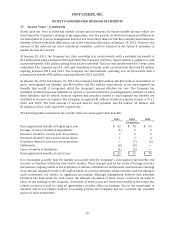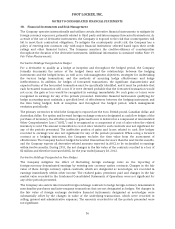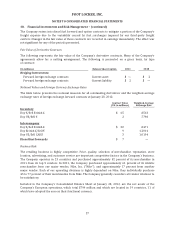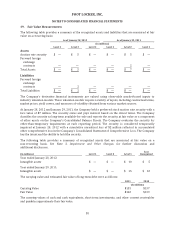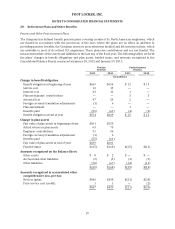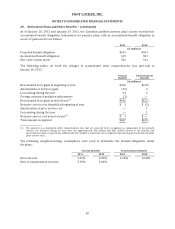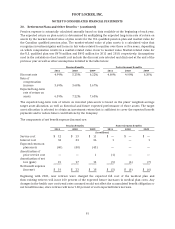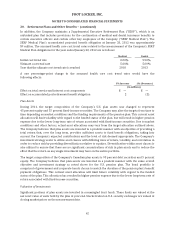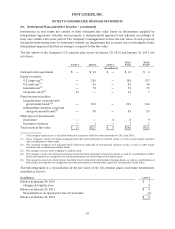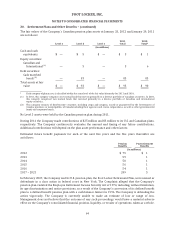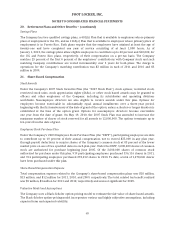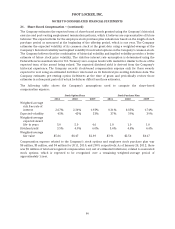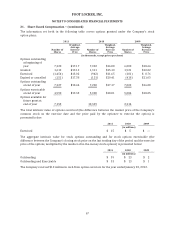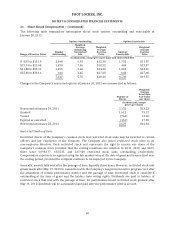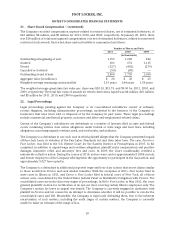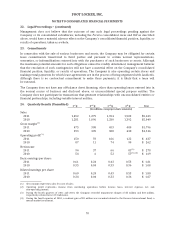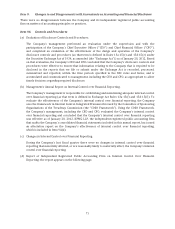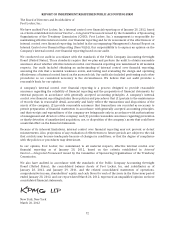Foot Locker 2011 Annual Report Download - page 85
Download and view the complete annual report
Please find page 85 of the 2011 Foot Locker annual report below. You can navigate through the pages in the report by either clicking on the pages listed below, or by using the keyword search tool below to find specific information within the annual report.FOOT LOCKER, INC.
NOTES TO CONSOLIDATED FINANCIAL STATEMENTS
20. Retirement Plans and Other Benefits − (continued)
Savings Plans
The Company has two qualified savings plans, a 401(k) Plan that is available to employees whose primary
place of employment is the U.S., and an 1165(e) Plan that is available to employees whose primary place of
employment is in Puerto Rico. Both plans require that the employees have attained at least the age of
twenty-one and have completed one year of service consisting of at least 1,000 hours. As of
January 1, 2012, the savings plans allow eligible employees to contribute up to 40 percent and $10,000, for
the U.S. and Puerto Rico plans, respectively, of their compensation on a pre-tax basis. The Company
matches 25 percent of the first 4 percent of the employees’ contributions with Company stock and such
matching Company contributions are vested incrementally over 5 years for both plans. The charge to
operations for the Company’s matching contribution was $2 million in each of 2011 and 2010 and $3
million in 2009.
21. Share-Based Compensation
Stock Awards
Under the Company’s 2007 Stock Incentive Plan (the ‘‘2007 Stock Plan’’), stock options, restricted stock,
restricted stock units, stock appreciation rights (SARs), or other stock-based awards may be granted to
officers and other employees of the Company, including its subsidiaries and operating divisions
worldwide. Nonemployee directors are also eligible to receive awards under this plan. Options for
employees become exercisable in substantially equal annual installments over a three-year period,
beginning with the first anniversary of the date of grant of the option, unless a shorter or longer duration is
established at the time of the option grant. Options for nonemployee directors become exercisable
one year from the date of grant. On May 19, 2010, the 2007 Stock Plan was amended to increase the
maximum number of shares of stock reserved for all awards to 12,000,000. The options terminate up to
ten years from the date of grant.
Employees Stock Purchase Plan
Under the Company’s 2003 Employees Stock Purchase Plan (the ‘‘ESPP’’), participating employees are able
to contribute up to 10 percent of their annual compensation, not to exceed $25,000 in any plan year,
through payroll deductions to acquire shares of the Company’s common stock at 85 percent of the lower
market price on one of two specified dates in each plan year. Under the ESPP, 3,000,000 shares of common
stock are authorized for purchase beginning June 2005. Of the 3,000,000 shares of common stock
authorized for purchase under this plan, 919 participating employees purchased 336,116 shares in 2011,
and 764 participating employees purchased 278,212 shares in 2010. To date, a total of 1,278,045 shares
have been purchased under this plan.
Share-Based Compensation Expense
Total compensation expense related to the Company’s share-based compensation plans was $18 million,
$13 million, and $12 million for 2011, 2010, and 2009, respectively. The total related tax benefit realized
was $5 million, $3 million for 2011 and 2010, respectively and was not significant for 2009.
Valuation Model and Assumptions
The Company uses a Black-Scholes option-pricing model to estimate the fair value of share-based awards.
The Black-Scholes option-pricing model incorporates various and highly subjective assumptions, including
expected term and expected volatility.
65


